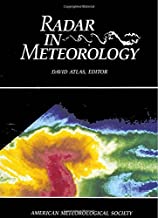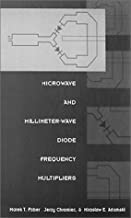Radar in Meteorology
Original price was: ₹104,361.30.₹83,489.04Current price is: ₹83,489.04.
ISBN: X933876866
Author/Editor: David Atlas
Publisher: Americal Metrological Society
Year: 1990
1 in stock (can be backordered)
Description
This fully illustrated volume covers the history of radar meteorology, deals with the issues in the field from both the operational and the scientific viewpoint, and looks ahead to future issues and how they will affect the current atmosphere. With over 200 contributors, the volume is a product of the entire community and represents an unprecedented compendium of knowledge in the field.
Additional information
| Weight | 2.2 kg |
|---|
Product Properties
| Year of Publication | 1990 |
|---|---|
| Table of Contents | 1.1 Introduction 1 .2 Electric and magnetic fields 2 1.2.1 The electric field 2 1.2.2 The magnetic field 4 1.2.3 Relating the electric and magnetic fields? simple dipole antenna 5 1.2.4 Maxwell equations 6 1.3 The nature of electromagnetic radiation 8 1.3.1 The electromagnetic spectrum 8 1.3.2 Electromagnetic wave interactions 9 1.4 Interactions of electromagnetic waves with matter 11 1.4.1 Refraction 12 1.4.2 Reflection 12 1.4.3 Mie scattering 14 1.4.4 Bragg scattering 17 1.4.5 Absorption 18 1.5 Polarization of electromagnetic waves 18 Important terms 20 Review questions 21 Challenge problems 22 2 Radar Hardware 23 2.1 Introduction 23 2.2 Frequency and wavelength 23 2.3 Components of a weather radar system 25 2.3.1 Transmitter section 26 2.3.2 Waveguides, rotary joints, polarization switching devices, and circulators 28 2.3.3 The antenna section 32 2.3.4 The receiver section 36 2.3.5 Magnetron transmitters 38 2.4 Specialized radar systems 40 2.4.1 Phased-array radars 40 2.4.2 Mobile and deployable radars 41 2.4.3 Airborne radars 43 2.4.4 Spaceborne radars 44 Important terms 46 Review questions 47 Challenge problems 47 3 Radar Characteristics 49 3.1 Introduction 49 3.2 Range and range ambiguity 50 3.3 The transmitted and received signal 53 3.3.1 Pulse duration and pulse length 54 3.3.2 Power and the duty cycle 54 3.4 Radar geometry and types of displays 56 3.4.1 Common radar displays in spherical coordinates 56 Important terms 64 Review questions 64 Challenge problems 64 4 The Path of a Radar Ray 66 4.1 Introduction 66 4.2 Ray propagation in an idealized atmosphere 67 4.2.1 Factors influencing radar ray paths 67 4.2.2 The path of a ray in an idealized atmosphere 69 4.2.3 The range and height of a pulse volume in space 72 4.3 Anomalous propagation 74 Important terms 78 Review questions 78 Challenge problems 79 5 Power and the Radar Reflectivity Factor 82 5.1 Introduction 82 5.2 Radar equation for a solitary target 83 5.2.1 Power flux density incident on a target 83 5.2.2 Power flux density scattered back to the radar 85 5.2.3 Backscattered power collected by the radar antenna 86 5.2.4 Implications of the radar equation 87 5.3 Radar equation for a distributed target 89 5.3.1 The contributing volume for distributed targets 89 5.3.2 The radar cross section of distributed targets 91 5.3.3 The radar equation for a distributed target 94 5.4 The weather radar equation 95 5.4.1 Radar cross section of a small dielectric sphere 95 5.4.2 The radar reflectivity factor 96 5.4.3 The weather radar equation 97 5.4.4 The validity of the Rayleigh approximation 98 5.5 Summary 100 Important terms 101 Review questions 101 Challenge problems 102 6 Radial Velocity?he Doppler Effect 104 6.1 Introduction 104 6.2 Measurement of radial velocity 106 6.2.1 Phase measurements and radial velocity retrieval 107 6.2.2 Velocity ambiguities and their resolution 108 6.3 Doppler spectra 115 6.3.1 Doppler spectra of weather and other targets 116 6.3.2 Moments of the Doppler spectrum 117 6.4 Measurement of the Doppler moments 119 6.5 Summary 122 Important terms 123 Review questions 123 Challenge problems 124 7 Dual-Polarization Radar 126 7.1 Introduction 126 7.2 The physical bases for radar polarimetry 127 7.3 Measuring polarimetric quantities 130 7.4 Reflectivity, differential reflectivity, and linear depolarization ratio 132 7.4.1 Reflectivity factor in the dual-polarization framework (ZHH and ZVV) 132 7.4.2 Differential reflectivity (ZDR) 133 7.4.3 Raindrop shapes and sizes 134 7.4.4 ZDR measurements in rain 138 7.4.5 ZDR measurements in ice and mixed-phase precipitation 141 7.4.6 Linear depolarization ratio (LDR) 145 7.5 Polarization and phase 149 7.5.1 Propagation differential phase shift (??DP) 150 7.5.2 Backscatter differential phase shift (??) 152 7.5.3 Specific differential phase (KDP) 152 7.5.4 Retrieval of KDP 155 7.5.5 Co-polar correlation coefficient (??HV) 162 7.5.6 Using polarimetric variables together 168 7.5.7 Covariation of the polarimetric variables: an example at Sand C-band 168 7.5.8 Using dual-polarization variables to discern meteorological versus non-meteorological echo and non-uniform beam filling 170 7.5.9 Hydrometeor classification 172 Important terms 176 Review questions 181 Challenge problems 181 8 Clear Air Echoes 183 8.1 Introduction 183 8.2 Ground clutter 184 8.2.1 Ground clutter characteristics 184 8.2.2 Sea clutter 185 8.2.3 Effects of anomalous propagation 188 8.2.4 Ground clutter mitigation 188 8.3 Echoes from biological sources 191 8.3.1 Insect echo 192 8.3.2 Birds and bats 193 8.4 Debris, dust, and smoke 195 8.5 Aircraft echoes and chaff 196 8.6 Other non-meteorological echo sources 198 8.6.1 The sun 199 8.6.2 Receiver noise 199 8.6.3 Radio interference 200 8.7 Bragg scattering 200 Important terms 203 Review questions 203 Challenge problems 204 9 Propagation Effects: Attenuation and Refractivity 205 9.1 Introduction 205 9.2 Attenuation 206 9.2.1 Attenuation by atmospheric gases and measurement of water vapor 207 9.2.2 Attenuation by cloud droplets and measurement of liquid water content 212 9.2.3 Attenuation by rain and its correction 214 9.2.4 Attenuation by hail 219 9.2.5 Short-wavelength radars and attenuation 224 9.3 Refractivity 225 9.3.1 Basic principles 226 9.3.2 Measurement of the water vapor field 227 Important terms 229 Review questions 229 Challenge problems 230 10 Operational Radar Networks 232 10.1 Introduction 232 10.2 The WSR-88D radar network 233 10.2.1 Network coverage 233 10.2.2 Radar characteristics and data distribution 234 10.2.3 Scanning strategies 236 10.2.4 Ground clutter suppression 240 10.2.5 Super resolution 240 10.2.6 Additional features 242 10.3 Terminal Doppler weather radars 242 10.3.1 Radar characteristics and data distribution 243 10.4 International operational radar networks 246 Important terms 248 Review questions 249 Challenge problems 249 11 Doppler Velocity Patterns and Single-Radar Wind Retrieval 251 11.1 Introduction 251 11.2 Kinematic properties of the wind field 252 11.3 Doppler radial velocity patterns and the wind field 254 11.3.1 Large-scale flow patterns 255 11.3.2 Fronts 257 11.3.3 Convective scale flow patterns 259 11.4 Wind retrieval with profiling radars 261 11.4.1 Wind profilers 261 11.5 Velocity?zimuth display wind retrieval 264 11.5.1 VAD technique 264 11.5.2 Extended VAD analysis 272 Important terms 275 Review questions 276 Challenge problems 277 12 Multiple Doppler Wind Retrieval 279 12.1 Introduction 279 12.2 Network design and deployment 279 12.2.1 Meteorological considerations 281 12.2.2 Sampling limitations 281 12.2.3 Siting and logistics 283 12.3 Characteristics of single Doppler data 284 12.3.1 Geographic location of a range gate 284 12.3.2 Characteristics of raw data 284 12.3.3 Ambiguities and Doppler radar data editing 287 12.4 Procedures for multiple Doppler syntheses 290 12.4.1 Interpolation of data from spherical to Cartesian coordinates 290 12.4.2 Transformation of radial velocities to orthogonal particle motion components 292 12.4.3 Calculation of vertical motion from orthogonal wind components 302 12.4.4 Uncertainty in vertical motion retrievals 304 12.5 Summary 306 Important terms 306 Review questions 307 Challenge problems 308 13 Precipitation Estimation with Radar 310 13.1 Introduction 310 13.2 Measurement of precipitation rate, total precipitation, and particle size distributions 311 13.2.1 Precipitation gauges 311 13.2.2 Disdrometers 313 13.2.3 Optical array probes 315 13.3 Nature of particle size distributions 316 13.3.1 The exponential size distribution 318 13.3.2 The gamma size distribution 319 13.4 Radar remote sensing of precipitation 319 13.4.1 Determining Z? relationships 322 13.4.2 Challenges in precipitation estimation with radar 323 13.5 Precipitation estimation using dual polarization 326 13.6 Winter precipitation 329 13.7 Measuring precipitation from space 330 13.7.1 Tropical Rainfall Measuring Mission 332 13.7.2 Global Precipitation Mission 332 Important terms 334 Review questions 334 Challenge problems 335 14 Warm Season Convection 338 14.1 Introduction 338 14.2 Mesoscale convective systems 339 14.2.1 Radar-observed life cycle of an MCS 339 14.2.2 Conceptual model of an MCS as observed with a research radar 341 14.2.3 Radar signatures of hazardous weather in MCSs 343 14.2.4 Frontal squall lines 345 14.3 Supercell thunderstorms 349 14.3.1 Tornado detection 352 14.3.2 Radar signatures of supercells 354 14.3.3 Hail detection 356 14.4 Downbursts and wind shear 358 Important terms 358 Challenge problems 359 15 Extratropical Cyclones 361 15.1 Introduction 361 15.2 Radar approaches to monitor cyclone mesostructure 363 15.3 Mesoscale structures observable with radar 366 15.3.1 The comma-cloud tail 367 15.3.2 The comma-cloud head 371 Important terms 381 Review questions 381 Challenge problems 382 16 Tropical Cyclones 383 16.1 Introduction 383 16.2 Airborne and satellite radar systems for tropical cyclone research and operations 386 16.2.1 NOAA WP-3D radar systems 386 16.2.2 Other airborne radars used in hurricane research 388 16.2.3 Satellite radars used in hurricane research 389 16.3 Tropical cyclone structure and kinematics 390 16.3.1 Eyewall and eye radar structure 395 16.3.2 Radar structure of principal band 399 16.3.3 Other bands within the hurricane vortex 404 16.4 Operational use of radar to detect tropical cyclone hazards 405 16.4.1 High winds and storm surge 405 16.4.2 Heavy precipitation and flooding 407 16.4.3 Tornadoes 409 Important terms 411 Review questions 411 Challenge problems 412 17 Clouds and Vertical Motions 413 17.1 Introduction 413 17.2 Cloud radars 414 17.2.1 Advantages and disadvantages of cloud radars 415 17.2.2 Examples of data from cloud radars 417 17.3 Application of cloud radars 421 17.3.1 Determining vertical motions in clouds 421 17.3.2 Determining statistical cloud properties 424 17.3.3 Understanding atmospheric and storm structure 428 17.3.4 Understanding global cloud properties 432 Important terms 432 Review questions 433 Challenge problems 433 Appendix A List of Variables (and Chapters) 435 Appendix B Derivation of the Exact Equation for a Ray Path through a Spherically Stratified Atmosphere 441 Index 443 |
| Author | David Atlas |
| ISBN/ISSN | X933876866 |
| Binding | Hardback |
| Edition | 1 |
| Publisher | Americal Metrological Society |
You must be logged in to post a review.






Reviews
There are no reviews yet.